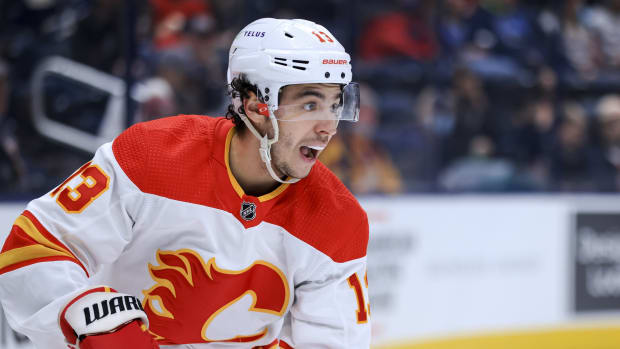
Aaron Doster-USA TODAY Sports
At the beginning of this season, the Calgary Flames were world-beaters.
Flames head coach Darryl Sutter had his players dialed in at both ends of the ice, and Calgary shut out their opponents a whopping seven times in their first 19 games. Unfortunately for the Flames, the COVID-19 pandemic struck them particularly hard, forcing 10 games to be postponed.
And by the time games were postponed, Calgary’s regression to the mean was already happening: they lost four in a row before the NHL paused the regular season in December, and since Jan. 4, they’ve gone 3-6-0, and been outscored 32-27. For every blowout loss they’ve suffered, the Flames have rebounded with a five, six, or seven-goal win over a solid team like St. Louis or Florida. The yo-yo effect is real, and apparent in Calgary.
So really, who are the Flames? A true Stanley Cup frontrunner, or a patchwork group of talent decent enough to make the playoffs, but not consistently good enough to win a bunch of post-season rounds?
At first glance, what stands out about Calgary is it has some high-quality offense-minded players. Most NHL teams would be happy to employ wingers Johnny Gaudreau and Matthew Tkachuk. But when you look at their depth of talent at center, there’s just not enough of it to allow Calgary to match up well against other teams in the weak Pacific Division. And as we all know, you almost always need a difference-maker or two down the middle to win a Cup, and the Flames don’t have that at present;.
They’ve managed to offset that lack of depth at center by getting great offensive production from their defense corps; Top blueliners Rasmus Andersson and Noah Hanifin have combined to generate 32 assists and 37 points, while blueliner Oliver Kylington has posted four goals and 19 points. However, the Flames’ defensemen have been bailed out by No. 1 goalie Jacob Markstrom too many times this year, and now that he can’t work miracles every other game, Markstrom hasn’t had the defense return the favor night-in-and night-out.
Calgary’s lack of secondary scoring this year certainly hasn’t helped Sutter. Forward Andrew Mangiapane has been a revelation on the wing (19 goals in 39 games), but the dropoff in talent is severe after that. Calgary’s bottom-11 forwards are a dog’s breakfast that includes oldtimers nearing the end of their careers (33-year-old winger Milan Lucic, 32-year-old center Mikael Backlund, and 35-year-old winger Trevor Lewis), and worker bees (Blake Coleman, Brett Ritchie). Their overall forward group is not one of the more intimidating in the game.
Flames GM Brad Treliving has at the moment only approximately $1.1 million in salary cap space with which to try and improve his team, but according to CapFriendly.com, he’ll have more than $5.5 million to play with by the trade deadline. There were credible reports Calgary was a leading candidate to land center Jack Eichel before the former Sabres star was dealt to Vegas. Treliving knows what we all know – the Flames need help at center, and for that reason, Calgary very well could be in on the bidding for Flyers pivot Claude Giroux. Treliving may also consider bringing back former Flames captain Mark Giordano to shore up their defense.
Many people look at the number of games in hand Calgary has on the three teams ahead of them in the Pacific standings – they’ve got five games in hand on third-place Los Angeles and the first-place Golden Knights, and they’ve got seven games in hand on second-place Anaheim – and believe they’ll solidify their status as a playoff team when they play those makeup games. That’s possible, but their win percentage of .590 is perilously close to sixth-place Edmonton (.564). One bad week or two could be the difference between missing and making the playoffs.
Missing the playoffs could end Treliving’s tenure as GM, and cause his successor to begin to break up the core of their organization. Even a first-round loss would be considered a letdown for the Flames. And if they don’t address their Jeykll-and-Hyde performance thus far this year, change will almost assuredly be coming.
